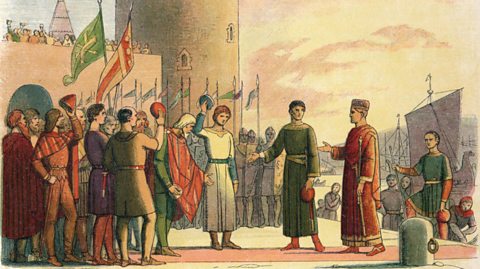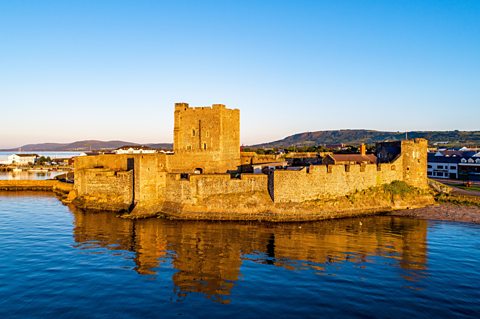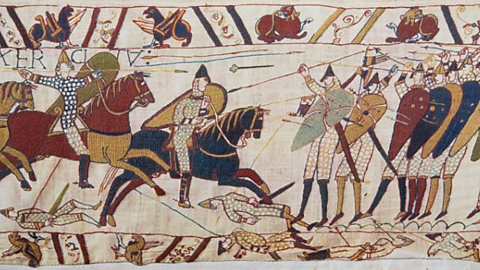Key points about Medieval Islamic civilisations
- After conquering England, William needed to secure his control of the people and land.
- He rewarded his closest supporters with large areas of land to manage on his behalf. This is often referred to as the feudal system.
- There was a huge divide in England between the lives of the wealthy nobles and the peasantry.
What do you think was the most important problem that William needed to solve?
1. Opposition in the North
2. Controlling the land
3. Protecting his soldiers and supporters
4. Knowing little about England and its people
All four problems were important for different reasons
1. Opposition in the North
There was support in the north of England for Edgar the Atheling to become king. This was a huge threat to William. Rebellions in the North could threaten his rule and needed to be dealt with. The Harrying of the North dealt with the northern opposition.
2. Controlling the land
William needed to make sure that the people who owned land were supportive of his rule. If large landowners opposed him then they could raise money and possibly an army to rebel against him. His division of land ownership, the feudal system, solved this.
3. Protecting his soldiers and supporters
William needed to quickly find a way to protect his supporters and soldiers in England. Motte-and-bailey castles were built all over the country to protect his supporters.
4. Knowing little about England and its people
To raise taxes and run the country effectively, William needed to know who owned land and how much money they had. This wasnât as immediate as the other problems. He also wanted to raise money to fund an army to protect his land in case of invasion, meaning he had to find out who he could tax. The Domesday Book was produced to give William this information.
What is the feudal system?
feudalismA system of land ownership to run the country, with the king at the top, followed by the nobility and peasants at the bottom. is a way of looking at how society was organised in medieval times. The phrase âfeudal systemâ wasnât used at the time, but it started to be used by historians from the 18th century onwards to try to describe what life was like in the Middle Ages.
Feudalism is now thought to be quite a simplistic way of looking at how medieval society worked, but it does give a starting point as to how power was spread across different groups of people.
How was the feudal system organised?
The feudal system shows the hierarchyAn order of importance, from highest to lowest. In the feudal system, the king was at the top and peasants were at the bottom. of different groups of people in medieval society.
The king was at the top of society, and therefore at the top of the feudal system. When he conquered England, King William took all of the land in the country. To manage this, he gave large areas of land to noblemen, including the clergyReligious leaders in the church such as priests or bishops., lordLandowners who leased out land to other people, usually peasants. Lords were often close advisors of the monarch. and baronsBarons were a lower rank of the nobility. They were often committed to providing military service to the king., in return for them raising him money and an army.
The nobilityMembers of the ruling class, just below the king in the feudal system. were below the king in the hierarchy. This included the clergy, barons, and lords and ladies. They would distribute some of their land to knights, who would raise an army to fight for the king when needed. Noblemen would also let peasants live and work on the land, in return for taxes and food. The nobility became wealthy from rent raised from peasants they let farm on the land.
Peasants were the largest and lowest group in medieval society, making up over 90% of the population. Most peasants were villeinsPeasants who were at the bottom of the feudal system. They worked and lived in land owned by a lord and were not allowed to leave without the lordâs permission. and they were at the bottom of the system. Some peasants were freemenFreemen were a minority of peasants who had the right to move around the country and work on different pieces of land. and they had more rights than villeins. Peasants had very few rights and little power on their own, however as a collective group they had the potential to threaten the power of the king. This was shown in the Peasants' Revolt in 1381.
The feudal system meant that everyone in England, apart from the king, was a tenantSomeone who lives on land owned by someone else and has to pay to live on and use the land.. Barons or Lords who were given land directly from the king were known as tenants-in-chiefThe supporters who William put in charge of most of the land. This group were also some of his closest advisors..
The feudal system allowed William to control land in England. In 1087, fearing possible revolts against him, William gathered his tenants-in-chief together at Old Sarum and made them take an oath of loyalty to him. This was a way of William demonstrating his power over England and trying to secure his land.
Activity - Put the feudal system in order
How do we know what medieval society was like?
William needed to work out how much land and money people in England owned, so he sent out his men to gather a complete record. The Domesday BookThe Domesday Book was a survey of England to establish what every person owned. This helped William establish control over England and raise taxes. was a detailed survey of what life was like in medieval England in 1086. It gives an idea about how society was structured and what life would have been like for different groups of people.
The inequality of the feudal system
There was great inequalityWhere a system means some people are better off than others, such as in pay, working rights or the law. in medieval society because of the distribution of land and wealth. The nobility was able to raise large amounts of money from payments from peasants living on their land. Peasants were usually villeinsVilleins were peasants who lived and worked on the land of a local lord. They were not allowed to leave the land without permission.. This meant they were legally tied to the land they worked on and could only leave with their Lordâs permission. If they had a bad harvest, they faced possible starvation. freemenFreemen were a minority of peasants who had the right to move around the country and work on different pieces of land. were a minority of peasants who were allowed to move around to work on different land.
There was a belief in medieval England that you would stay at the society level you were born into. So, if you were born a peasant, you would almost always stay a peasant. Peasants' lives were heavily controlled by those above them in society: the nobility, the Church and the king.
Inequality was written into the law. If someone was murdered, the compensation was called a WeregildWeregild translates as âman price.â It is the value, or price of someoneâs life owed to their family in compensation if they were killed.. The higher someone was in society, the more compensation their family would be paid.
Consequences of the feudal system
This unequal distribution of power and wealth had several implications throughout the medieval period.
- In 1215, King John signed the Magna Carta, which was a document that set out how power and decisions would be made between the monarch and powerful nobility. It took away some of the power of the monarch and meant future kings or queens would have reduced power and would be unable to make all decisions on their own.
- In 1381, the Peasants' Revolt took place which was partly caused by the peasants being angry at unfair taxes and restrictions on their freedoms.
Test your knowledge
Play the History Detectives game! gamePlay the History Detectives game!
Analyse and evaluate evidence to uncover some of historyâs burning questions in this game.

More on The Normans
Find out more by working through a topic
- count5 of 6

- count6 of 6

- count1 of 6

- count2 of 6
